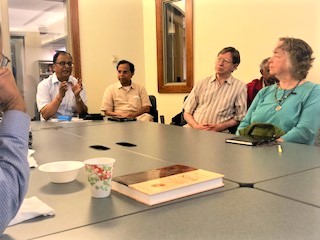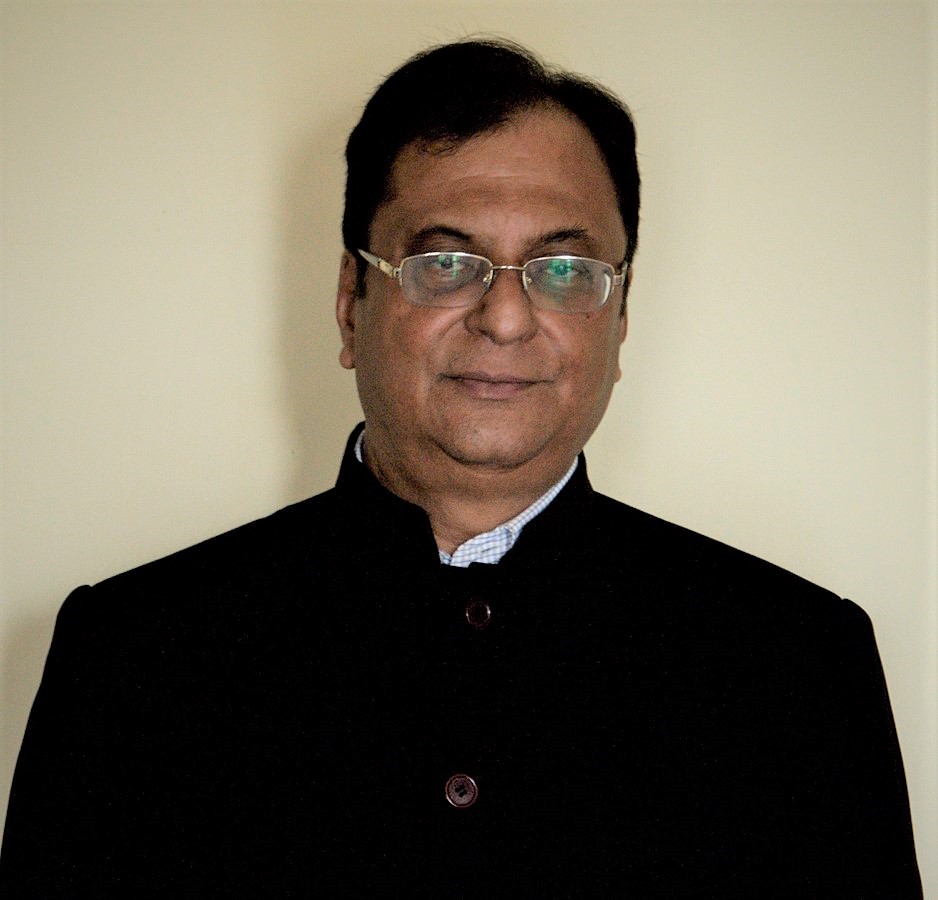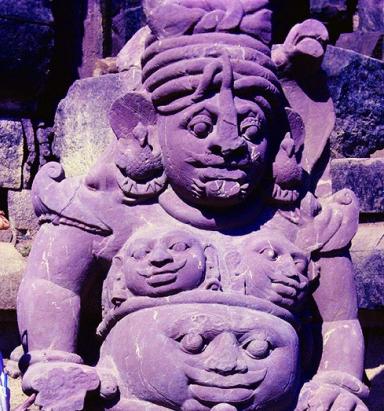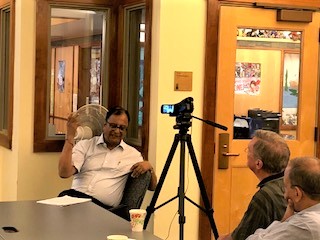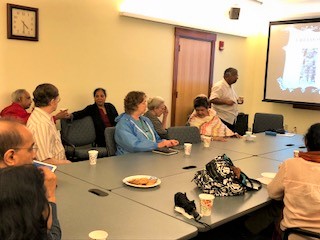Contribute
| Iconology Of Shiva: A Seminar By Dr. Kalyan Kumar Chakrabarty |
Jaidev Dasgupta
08/23/2018
In this day and age, when
new scientific and technological knowledge is growing at an ever-increasing
pace, what can one expect to learn from a 1,500-year old statue unearthed from
a forested, tribal area in India? Well, the answer is - it
depends on how one looks at the statue. Dr. Kalyan K. Chakravarty is among a
handful of people for whom such statues and artefacts are of immense interest
and great value - they try to read what these images from antiquity are saying
to us, and what we can learn from them. Dr. Chakravarty was an
officer in the prestigious Indian Administrative Service (IAS), but followed up
his passion for art history, religion and symbology in Indian religion despite
being immersed in administration in troubled spots in India. He has produced a
massive, scholarly two-volume book called Walking
with Shiva. On August 11, 2018, the India Discovery Center of Lincoln,
Massachusetts, hosted a talk by him on the “Iconology of Shivaâ€. The seminar was held at
the Learning Center of Cary Memorial Library in Lexington, MA. Many
distinguished scholars were present in this informative presentation and a
detailed Q&A session. After a brief
introduction, Dr. Chakravarty delved into the question “Who is Shiva?†Shiva is
one of the gods in the Hindu Trinity of – Brahma, Vishnu and Mahesh (or Shiva).
In the Rig Veda, Shiva is known as Rudra, who has two contrasting natures: on the
one hand, he is feared for his wild and destructive nature, and for bringing
disease; hence prayers are offered to him, to keep his ill-will away. On the
other hand, he is worshipped as a wise, beautiful, bountiful god, the Lord of
beasts, Pashupati, who brings healing
to men (RgVeda 1.114.1-10; Griffith). Dr. Chakravarty showed a
number of statues and engravings of Shiva from different periods, unravelling the
narratives and the cognitive roots of these figures, which display both the
merciful and ferocious aspects of the deity, as well their philosophical significance.
For instance, a seal from the Harappan culture shows a human figure sitting in
a cross-legged, yogic posture, surrounded by various animals, believed to be
the image of Pashupati, or “the Lord
of beastsâ€, discussed in the Vedic tradition. Splitting the term Pashupati into two - Pashu (animal) and Pati (master) - Dr. Chakravarty explained the term to mean a being wherein
the animal (or the so-called lower) side of our being meets the master (or the
higher) side, leading to real joy or bliss descending on us. This realization
goes beyond the subject-object or the mind-body dichotomy – and the resolution
of this results in cessation of pain, grief, anxiety and suffering in life. Along the same lines, Dr.
Chakravarty also briefly touched on the idea of Saguna-Nirguna Brahman, suggesting that when the Saguna (with attributes) is taken away,
or when one rises beyond attributes (gunas)
– the manifested aspect of creation –one meets the Nirguna or the attribute-less Brahman. With this framework of
duality or of two opposites in one, Dr. Chakravarty set the stage for sharing
his understanding of the 14-feet tall statue that was excavated in 1987 at Tala,
in a tribal area of Chhattisgarh (see attached image). This is a 5th
century image of a being with animals and dwarf heads carved on it. Several
international as well as Indian scholars have been baffled by this enigmatic statue,
consisting of so many images in one: they have interpreted it as the figure of
a demon, or even stated that it is a visual conundrum, without any metaphysical
meaning. But Dr. Chakravarty
explained that these scholars did not have the advantage of access to many
supporting texts, inscriptions, and the knowledge of current practices in the area
where the statue was found, nor did they scrutinize this information to
decipher the meaning of the image. He was referring to the numerous 5th
to7th century A.D inscriptions. Brahmanas, Mahabharata and Vedic
texts that describe various animals and dwarf figures carved on the body of the
main figure: these inscriptions are present throughout the area where the
statue was excavated, including Vidarbha, Dakshina Koshala and Kalinga. An important factor that supports
the interpretation of this statue is that the Pashupata cult is predominant in the tribal area. Multiple versions
of Shiva-Shakti or Shiva-Parvati (the local names for Shiva and Parvati vary)
are worshipped in this area, using fertility rites. The long-term presence of the associated cults in this region lends credence to the possibility that the statue
displays the multivalent aspects of Shiva simultaneously and reconciles them. Thus, based on a massive
amount of information, the underlying thesis of Many-in-One, and the knowledge
of the Pashupat cult in the tribal
area, Dr. Chakravarty deciphered the symbology of the ancient statue. Two categories of
creatures – malignant and beneficent, or poisonous and non-poisonous – are carved
on the body of Rudra. Harmful creatures such as the lizard and crab are in juxtaposition
to the harmless creatures such as the peacocks and fish. For instance, Rudra’s
nose is a lizard, his chin a crab, his moustache is a pair of fish, his ears
are two peacocks, and so on. Likewise, the faces of dwarfs or ganas – the cohort of Shiva – display
either ignorance and obtuseness, or happiness. The gradually increasing
happiness reflected on these faces, starting from the lower part of the body and
moving upwards, with the final gravitas on the face of Rudra, represents an increasing
realization of oneself being the same as the ultimate reality; or the Saguna (manifested) coming to realize that
it is the same as the Nirguna (unmanifested).
The changing expressions of happiness go along with the ascent of
consciousness. While ignorance leads to experiencing separation and alienation
from the ultimate reality, bliss culminates in the realization of being one
with the divinity, or of the divine within oneself. Thus, the statue of Rudra
represents the composite of opposite polarities of both good and bad, ignorance
and enlightenment, suffering and joy - all in one universal Being, the Merger
of being with the Being. Interpreting ancient
texts and images is a challenging task, as the interpreter must look at the
past through the lens of the present. The inability to transpose oneself to an
ancient culture in the past is a roadblock to such interpretation. In the
process of such interpretation, the availability of other related, contemporary
texts and inscriptions help to keep us from injecting and imposing the present
view on the past, thus allow us to offer a more reliable understanding of the
views of the artist and of the people around him or her in that era. Dr. Chakravarty believes
that separation of art from life, in order for the art to be preserved and
enjoyed in museums is unnatural and unwarranted. For him, art is life and living
life is art. Life or living entails doing, which involves art. Life divorced
from art is dull – focusing merely on the material, mechanistic and economic aspects
of it, devoid of any metaphysics or the possibility of realization of who one
is, the cause of one’s alienation and suffering, and the prospect of achieving joy
from oneness with reality. According to him, tribal people do not separate art
from life, perhaps they do not even understand art outside of life. They build
a statue based on the way they see and experience life. Rudra’s image is a clear example of it - portraying
their vision of the convergence of nature and culture.
Various questions from
the audience added information on the local cultures and village life in the
area. Such indigenous cultural artifacts have not yet been discovered elsewhere
in India yet. The speculation about the influence of Buddhism into the popular
belief systems also needs exploration.
Dr. Chakravarty suggested that the entire track of Mahanadi River from
lower Chhattisgarh to Bay of Bengal is a fertile area for archaeological
research. __________________________________________________________________ India Discovery Center, a local non-profit volunteer group, is dedicated to the creation of educational initiatives on Indian culture and traditions for youth and the public. For more information, please visit http://www.indiadiscoverycenter.org
You may also access this article through our web-site http://www.lokvani.com/
